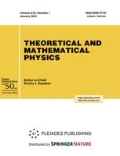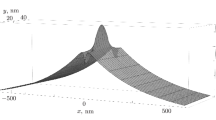Abstract
Using the Bogoliubov–de Gennes Hamiltonian, we analytically study two models with superconducting order, the p-wave model with an impurity potential and the s-wave nanowire model with superconductivity induced by the proximity effect with an impurity potential in a Zeeman field with a spin–orbit interaction. Using the Dyson equation, we study conditions for the emergence of Andreev bound states with energies close to the boundary of the superconducting gap and the possibility for these states to pass into Majorana-like bound states. We prove that in the topological phase (in the p-wave case also in the trivial phase) for both models, the Andreev bound states with energy close to the boundary of the superconducting gap can exist, but although their emergence in the p-wave model is due to the appearance of a (nonmagnetic) impurity, they appear in the s-wave model only as a result of a local perturbation of the Zeeman field. For both models, the transition of the Andreev bound states into the Majorana states (and back) is impossible in the topological phase, which is explained by the topological protection of the Majorana-like bound states in the topological phase.
Similar content being viewed by others
References
S. R. Elliot and M. Franz, “Colloquium: Majorana fermions in nuclear, particle, and solid-state physics,” Rev. Modern Phys., 87, 137–163 (2015); arXiv:1403.4976v2 [cond-mat.supr-con] (2014).
J. Alicea, “New directions in the pursuit of Majorana fermions in solid state systems,” Rep. Prog. Phys., 75, 076501 (2012); arXiv:1202.1293v1 [cond-mat.supr-con] (2012).
M. Sato and S. Fujimoto, “Majorana fermions and topology in superconductors,” J. Phys. Soc. Japan, 85, 072001 (2016); arXiv:1601.02726v2 [cond-mat.supr-con] (2016).
R. M. Lutchyn, E. P. A. M. Bakkers, L. P. Kouwenhoven, P. Krogstrup, C. M. Marcus, and Y. Oreg, “Majorana zero modes in superconductor–semiconductor heterostructures,” Nature Rev. Mater., 3, 52–68 (2018); arXiv:1707.04899v2 [cond-mat.supr-con] (2017).
F. von Oppen, Y. Peng, and F. Pientka, “Topological superconducting phases in one dimension,” in: Topological Aspects of Condensed Matter Physics (Lect. Notes Les Houches Summer School, Vol. 103, C. Chamon, M. O. Goerbig, R. Moessner, and L. F. Cugliandolo, eds.), Oxford Univ. Press, Oxford (2017), pp. 387–449.
K. Sengupta, I. Žutic, H.-J. Kwon, V. M. Yakovenko, and S. D. Sarma, “Midgap edge states and pairing symmetry of quasi-one-dimensional organic superconductors,” Phys. Rev. B, 63, 144531 (2001); arXiv:cond-mat/0010206v3 (2000).
V. Mourik, K. Zuo, S. M. Frolov, S. R. Plissard, E. P. A. M. Bakkers, and L. P. Kouwenhoven, “Signatures of Majorana fermions in hybrid superconductor–semiconductor nanowire devices,” Science, 336, 1003–1007 (2012).
A. Das, Y. Ronen, Y. Most, Y. Oreg, M. Heiblum, and H. Shtrikman, “Zero-bias peaks and splitting in an Al–InAs nanowire topological superconductor as a signature of Majorana fermions,” Nature Phys., 8, 887–895 (2012); arXiv:1205.7073v2 [cond-mat.mes-hall] (2012).
M. T. Deng, S. Vaitiekėnas, E. B. Hansen, J. Danon, M. Leijnse, K. Flensberg, J. Nygård, P. Krogstrup, and C. M. Marcus, “Majorana bound state in a coupled quantum-dot hybrid-nanowire system,” Science, 354, 1557–1562 (2016); arXiv:1612.07989v2 [cond-mat.mes-hall] (2016).
L. P. Rokhinson, X. Liu, and J. K. Furdyna, “The fractional a.c. Josephson effect in a semiconductor–superconductor nanowire as a signature of Majorana particles,” Nature Phys., 8, 795–799 (2012); arXiv:1204.4212v2 [cond-mat.mes-hall] (2012).
C.-X. Liu, J. D. Sau, T. D. Stanescu, and S. Das Sarma, “Andreev bound states versus Majorana bound states in quantum dot–nanowire–superconductor hybrid structures: Trivial versus topological zero-bias conductance peaks,” Phys. Rev. B, 96, 075161 (2017); arXiv:1705.02035v2 [cond-mat.mes-hall] (2017).
C. Moore, C. Zeng, T. D. Stanescu, and S. Tewari, “Quantized zero-bias conductance plateau in semiconductor–superconductor heterostructures without topological Majorana zero modes,” Phys. Rev. B, 98, 155314 (2018); arXiv:1804.03164v1 [cond-mat.mes-hall] (2018).
A. Vuik, B. Nijholt, A. R. Akhmerov, and M. Wimmer, “Reproducing topological properties with quasi-Majorana states,” SciPost Phys., 7, 061 (2019); arXiv:1806.02801v3 [cond-mat.mes-hall] (2018).
C.-K. Chiu and S. D. Sarma, “Fractional Josephson effect with and without Majorana zero modes,” Phys. Rev. B, 99, 035312 (2019).
T. S. Tinyukova and Yu. P. Chuburin, “The role of Majorana-like bound states in the Andreev reflection and the Josephson effect in the case of a topological insulator,” Theor. Math. Phys., 202, 72–88 (2020).
Yu. P. Chuburin, “Existence of Majorana bound states near impurities in the case of a small superconducting gap,” Phys. E, 89, 130–133 (2017).
Yu. P. Chuburin, “Existence of Majorana bound states in a superconducting nanowire,” Theor. Math. Phys., 197, 1635–1644 (2018).
C. W. J. Beenakker, “Random-matrix theory of Majorana fermions and topological superconductors,” Rev. Modern Phys., 87, 1037–1066 (2015).
R. Aguado, “Majorana quasiparticles in condensed matter,” Riv. Nuovo Cimento, 40, 523–593 (2017); arXiv:1711.00011v2 [cond-mat.supr-con] (2017).
T. S. Tinyukova, “Majorana states in a \(p\)-wave superconducting nanowire [in Russian],” Vestn. Udmurtsk. Univ. Mat. Mekh. Komp. Nauki, 28, 222–230 (2018).
Yu. P. Chuburin, “On small perturbations of the Schrödinger equation with periodic potential,” Theor. Math. Phys., 110, 351–359 (1997).
Yu. P. Chuburin, “On levels of a weakly perturbed periodic Schrödinger operator,” Commun. Math. Phys., 249, 497–510 (2004).
S. D. Sarma, A. Nag, and J. D. Sau, “How to infer non-Abelian statistics and topological visibility from tunneling conductance properties of realistic Majorana nanowires,” Phys. Rev. B, 94, 035143 (2016).
Yu. N. Demkov and V. N. Ostrovsky, Method of Zero-Range Potentials in Atomic Physics [in Russian], Lenigrad Univ. Press, Leningrad (1975); English transl.: Zero-Range Potentials and Their Application in Atomic Physics,, Plenum, New York (1988).
S. K. Adhikari, M. Casas, A. Puente, A. Rigo, M. Fortes, M. A. Solis, M. de Llano, A. A. Valladares, and O. Rojo, “Linear to quadratic crossover of Cooper-pair dispersion relation,” Phys. C, 351, 341–348 (2001); arXiv:cond-mat/0008478v1 (2000).
M. Sato and Y. Ando, “Topological superconductors: A review,” Rep. Prog. Phys., 80, 076501 (2017).
S. Datta, Quantum Transport: Atom to Transistor, Cambridge Univ. Press, Cambridge (2005).
J. Viljas, “Molecular electronics, a brief introduction,” https://www.researchgate.net/publication/242099017_ Molecular_electronics_a_brief_introduction (2011).
Yu. P. Chuburin and T. S. Tinyukova, “The emergence of bound states in a superconducting gap at the topological insulator edge,” Phys. Lett. A, 384, 126694 (2020).
Funding
The research of Yu. P. Chuburin was supported by the Urals Branch of the Russian Academy of Sciences (Program No. AAAA-A16-116021010082-8).
The research of T. S. Tinyukina was supported by the Ministry of Education and Science of the Russian Federation under state mission No. 075-00232-20-01, Project No. 0827-2020-0010 “Development of theory and methods of control and stabilization of dynamical systems.”
Author information
Authors and Affiliations
Corresponding author
Ethics declarations
The authors declare no conflicts of interest.
Appendix
We find the Green’s function of the Hamiltonian \( \mathcal{H} \), i.e., the kernel of the resolvent \(( \mathcal{H} -E)^{-1}\). Applying Fourier transform (3) to matrix (25), we obtain
We first find the Green’s function in the momentum representation by solving the equation \(( \widetilde { \mathcal{H} }(p)-E) \widetilde \psi= \widetilde \varphi \) for \( \widetilde \psi\). The determinant of matrix (A.1) is equal to
We compute the determinants \(d_j\), \(j=1,\dots,4\), which are obtained from the determinant of (A.1) by replacing the \(j\)th column with \(( \widetilde \varphi _{ \mathrm{e} \uparrow }, \widetilde \varphi _{ \mathrm{e} \downarrow }, \widetilde \varphi _{ \mathrm{h} \uparrow }, \widetilde \varphi _{ \mathrm{h} \downarrow })^{ \mathrm{T} }\). We then have
Rights and permissions
About this article
Cite this article
Chiburin, Y.P., Tinyukova, T.S. Mutual transition of Andreev and Majorana bound states in a superconducting gap. Theor Math Phys 205, 1666–1681 (2020). https://doi.org/10.1134/S0040577920120089
Received:
Revised:
Accepted:
Published:
Issue Date:
DOI: https://doi.org/10.1134/S0040577920120089




